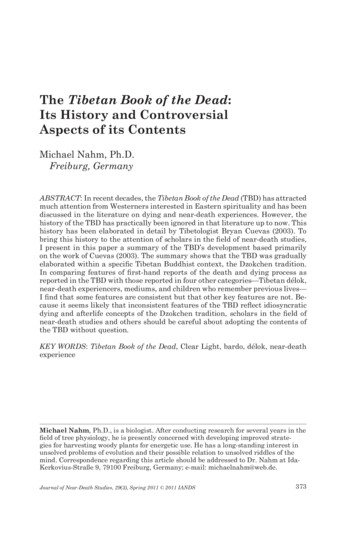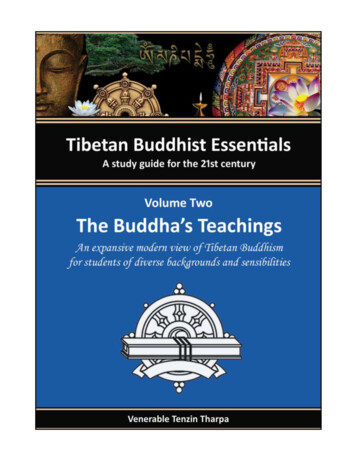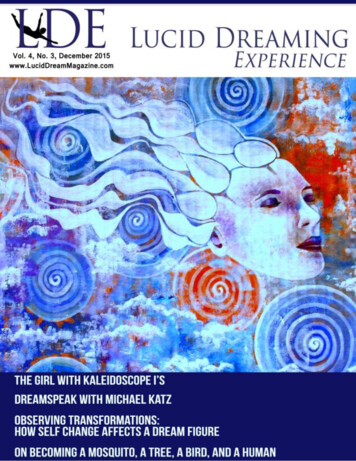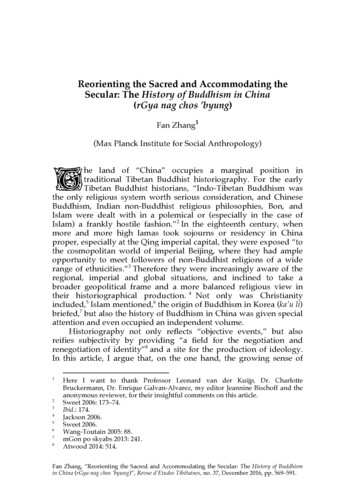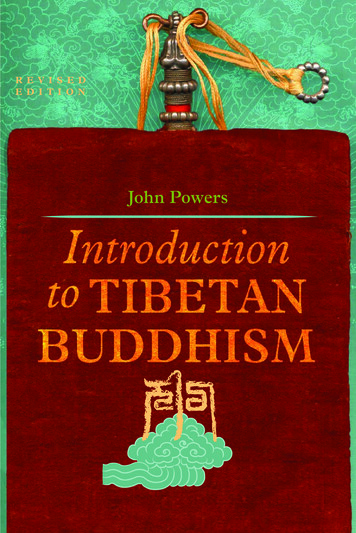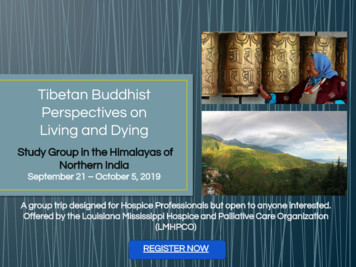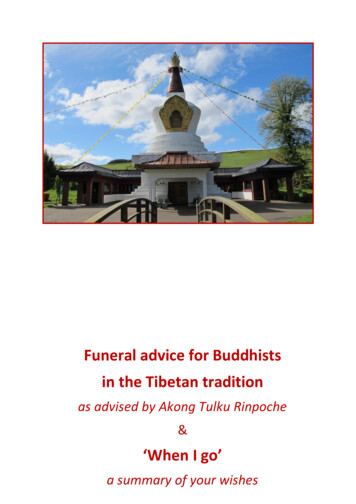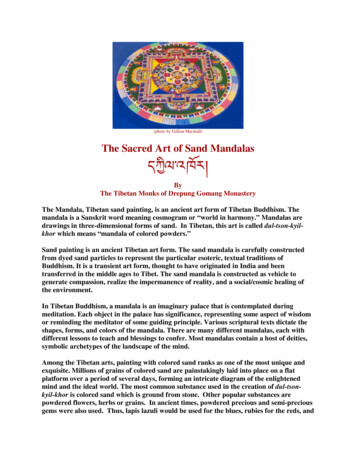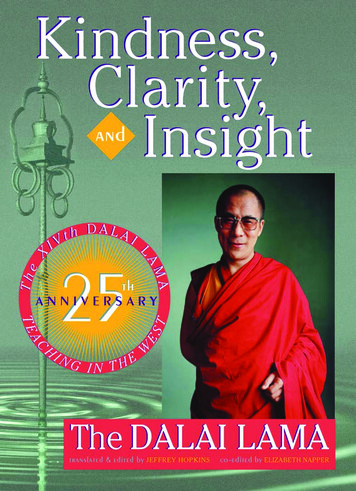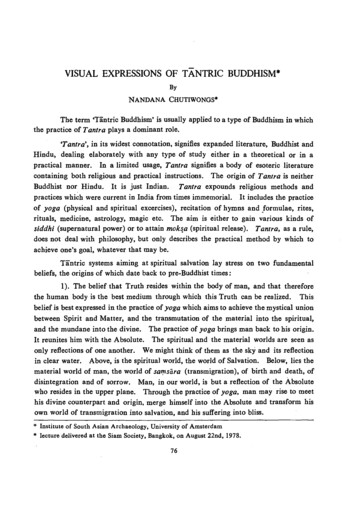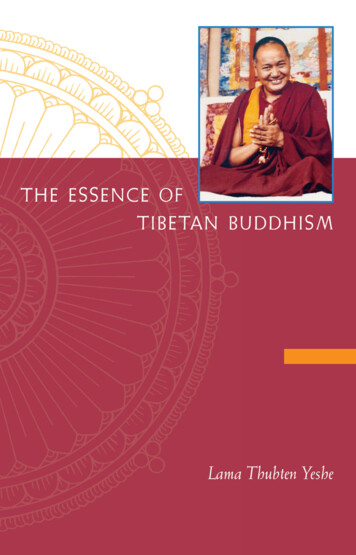
Transcription
The Essence of Tibetan Buddhism
This book is published byLama Yeshe Wisdom ArchiveBringing you the teachings of Lama Yeshe andLama Zopa RinpocheThis book is made possible by kind supporters of the Archive who,like you, appreciate how we make these teachings freely available inso many ways, including in our website for instant reading, listeningor downloading, and as printed and electronic books.Our website offers immediate access to thousands of pages of teachingsand hundreds of audio recordings by some of the greatest lamas of ourtime. Our photo gallery and our ever-popular books are also freelyaccessible there.Please help us increase our efforts to spread the Dharma for the happinessand benefit of all beings. You can find out more about becoming a supporterof the Archive and see all we have to offer by visiting our website athttp://www.LamaYeshe.com.Thank you so much, and please enjoy this ebook.
Previously Published by the LAMA YESHE WISDOM ARCHIVEBecoming Your Own Therapist, by Lama YesheAdvice for Monks and Nuns, by Lama Yeshe and Lama Zopa RinpocheVirtue and Reality, by Lama Zopa RinpocheMake Your Mind an Ocean, by Lama YesheTeachings from the Vajrasattva Retreat, by Lama Zopa RinpocheThe Peaceful Stillness of the Silent Mind, by Lama YesheDaily Purification: A Short Vajrasattva Practice, by Lama Zopa RinpocheMaking Life Meaningful, by Lama Zopa RinpocheTeachings from the Mani Retreat, by Lama Zopa RinpocheThe Direct and Unmistaken Method, by Lama Zopa RinpocheThe Yoga of Offering Food, by Lama Zopa RinpocheTeachings from Tibet, by various great lamasThe Joy of Compassion, by Lama Zopa RinpocheThe Kindness of Others, by Geshe Jampa TegchokEgo, Attachment and Liberation, by Lama YesheHow Things Exist, by Lama Zopa RinpocheUniversal Love, by Lama YesheThe Heart of the Path, by Lama Zopa RinpocheTeachings from the Medicine Buddha Retreat, by Lama Zopa RinpocheFreedom Through Understanding, by Lama Yeshe and Lama Zopa RinpocheKadampa Teachings, by Lama Zopa RinpocheLife, Death and After Death, by Lama YesheBodhisattva Attitude, by Lama Zopa RinpocheHow to Practice Dharma, by Lama Zopa RinpocheFor Initiates Only:A Teaching on Heruka, by Lama Zopa RinpocheA Teaching on Yamantaka, by Lama Zopa RinpocheIn Association with TDL Publications, Los Angeles:Mirror of Wisdom, by Geshe Tsultim GyeltsenIlluminating the Path to Enlightenment, by His Holiness the Dalai LamaLama Yeshe DVDsThe Three Principal Aspects of the Path Introduction to Tantra Offering Tsok toHeruka Vajrasattva Anxiety in the Nuclear Age Bringing Dharma to the West Lama Yeshe at Disneyland Freedom Through Understanding Life, Death and AfterDeathMay whoever sees, touches, reads, remembers, or talks or thinks about these books neverbe reborn in unfortunate circumstances, receive only rebirths in situations conducive tothe perfect practice of Dharma, meet only perfectly qualified spiritual guides, quicklydevelop bodhicitta and immediately attain enlightenment for the sake of all sentientbeings.
Lama YesheThe Essence ofTibetan BuddhismThe Three Principal Aspects of the PathandAn Introduction to TantraEdited by Nicholas RibushLama Yeshe Wisdom Archive Bostonwww.LamaYeshe.comA non-profit charitable organization for the benefit of allsentient beings and an affiliate of the Foundation forthe Preservation of the Mahayana Traditionwww.fpmt.org
First published 200115,000 copies for free distributionSecond printing 2003, 15,000 copiesThird printing 2006, 10,000 copiesFourth printing 2008, 10,000 copiesFifth printing 2010, 10,000 copiesLama Yeshe Wisdom ArchivePO Box 636, Lincoln, MA 01773, USA Lama Thubten Zopa Rinpoche 2001, 2010Please do not reproduce any part of this book by any meanswhatsoever without our permissionLibrary of Congress Cataloging-in-Publication DataThubten Yeshe, 1935–1984.The essence of Tibetan Buddhism : the three principal aspects of the pathand introduction to Tantra / Lama Yeshe ; edited by Nicholas Ribush.p. cm.Summary: “In this book, Lama Yeshe, one of the pioneers of TibetanBuddhism in the West, presents the fundamental teachings of the tradition,the three principal aspects of the path to enlightenment—renunciation,bodhicitta and the right view of emptiness—and an overview of tantra,to which the basic teachings lead”—Provided by publisher.isbn 978-1-891868-08-5 (alk. paper)1. Buddhism—China—Tibet—Doctrines. I. Ribush, Nicholas. II. Title.bq7634.t48 2008294.3’923—dc22200803374210 9 8 7 6 5Cover, unknown photographer Cover line art by Robert BeerPhotos of Lama Yeshe at University of Santa Cruz, California, 1978,by Jon Landaw Designed by Gopa & Ted2 Inc. Printed in the USA with environmental mindfulness on 30% PCWrecycled paper. As a result we have saved the following resources: 11 trees,304 lbs. of solid waste, 5,010 gallons of water, 1,040 lbs. of greenhouse gasesand 3 million BTUs of energy. This paper is also FSC certified.For more information please visit www.fscus.orgPlease contact the Lama Yeshe Wisdom Archivefor more copies of this and our other free books
. . . Contents . . .Editor’s Preface11The Three Principal Aspects of the PathFirst Teaching15Second Teaching31Introduction to TantraFirst Teaching47Second Teaching61Glossary79
. . . Publisher’s Acknowledgments . . .We are extremely grateful to our friends and support-ers who have made it possible for the Lama Yeshe WisdomArchive to both exist and function: to Lama Yeshe and Lama ZopaRinpoche, whose kindness is impossible to repay; to Peter and Nicole Kedge and Venerable Ailsa Cameron for their initial work onthe Archive; to Venerable Roger Kunsang, Lama Zopa’s tireless assistant, for his kindness and consideration; and to our sustainingsupporters: Barry and Connie Hershey, Joan Halsall, Tony Steel,Vajrayana Institute, Claire Atkins, Thubten Yeshe, Roger and ClaireAsh-Wheeler, Hawk Furman, Richard Gere, Lily Chang Wu, Therese Miller, Janet Hintermann, Tom and Suzanne Castles, Doren andMary Harper, and other anonymous benefactors.In particular, we would like to express our appreciation to DossMcDavid for so kindly sponsoring the reprint of this book andfor his appreciation of and enthusiasm for the teachings of LamaThubten Yeshe. We have many more of Lama’s teachings availablefor sponsorship, so please contact us if you would like to help bringthem to others.We are also deeply grateful to all those who have become members of the Archive over the past few years. Details of our membership program may be found at the back of this book, and if you are
.8the essence of tibetan buddhism.not a member, please do consider joining up. Due to the kindnessof those who have, we now have several editors working on ourvast collection of teachings for the benefit of all. We have postedour list of individual and corporate members on our website, www.LamaYeshe.com.Furthermore, we would like to express our appreciation for thekindness and compassion of all those other generous benefactorswho have contributed funds to our work since we began publishingfree books. Thankfully, you are too numerous to mention individually in this book, but we value highly each and every donation madeto spreading the Dharma for the sake of the kind mother sentientbeings and now pay tribute to you all on our website. Thank you somuch.Finally, I would like to thank the many other kind people whohave asked that their donations be kept anonymous; my wife, WendyCook, for her constant help and support; our dedicated office staff,Jennifer Barlow and Ven. Ani Tenzin Desal; Ven. Ailsa Cameronfor her decades of meticulous editing; Ven. Connie Miller, GordonMcDougall, Michelle Bernard and our other editors; Ven. Kunsangfor his tireless work recording Lama Zopa Rinpoche; Ven. ThubtenLabdron, Ven. Thubten Munsel and Dr. Su Hung for their help withtranscribing; Sandy Smith and our team of volunteer web editors;Ven. Bob Alcorn for his incredible work on our Lama Yeshe DVDs;David Zinn for his digital imaging expertise; Jonathan Steyn for hishelp with our audio work; Mandala Books and Wisdom Books fortheir help with our distribution in Australia and Europe and Amitabha Buddhist Centre and Losang Dragpa Centre for their help
.publisher’s acknowledgment.9with our distribution in Singapore and Malaysia respectively; andeverybody else who helps us in so many ways. Thank you all.If you, dear reader, would like to join this noble group of openhearted altruists by contributing to the production of more booksby Lama Yeshe or Lama Zopa Rinpoche or to any other aspect ofthe Lama Yeshe Wisdom Archive’s work, please contact us to findout how.—Dr. Nicholas RibushThrough the merit of having contributed to the spread of the Buddha’steachings for the sake of all sentient beings, may our benefactorsand their families and friends have long and healthy lives,all happiness, and may all their Dharmawishes be instantly fulfilled.Benefactor’s DedicationIt is a privilege to have an opportunity to help spread the teachings ofthe Buddha. May these transcripts of Lama Yeshe’s talks help manyseekers to find the way to liberation and perfect enlightenment.—Doss McDavid
. . . Editor’s Preface . . .This publication is the third in our series of free books byLama Yeshe, following the extremely popular and well re-ceived Becoming Your Own Therapist and Make Your Mind an Ocean.It differs, however, in that the material contained herein is alsoon video, which we have put onto DVD (see the back pages of thisbook for details), so that you can now see and hear Lama Yeshe giving these teachings. We have edited this book less intensively thannormal so that the text quite closely adheres to Lama’s originalwords and phraseology, making it easier to follow when watchingthe DVDs. For the same reason, we have also left intact Lama’s references to world events of the time, such as the various Middle Eastdramas of 1979–80.Lama’s teachings were dynamic events full of energy and laughter.He taught not only verbally but physically and facially as well. Thus,we encourage you to get the DVDs of these teachings in order to getas total an experience of the incomparable Lama Yeshe as possible.The first teaching, “The Three Principal Aspects of the Path,” wasgiven in France in 1982, during an FPMT-sponsored tour of Europeby His Holiness the Dalai Lama. Just before His Holiness’s scheduledteachings at Institut Vajra Yogini, His Holiness manifested illnessand asked Lama Yeshe to fill in for a couple of days—to “baby-sit”
12.the essence of tibetan buddhism.the audience, as Lama put it. This wonderful two-part teaching onthe three principal aspects of the path is the result.The second teaching, an “Introduction to Tantra,” also in twoparts, was given at Grizzly Lodge, California, in 1980. It comprisesthe first two lectures of a commentary on the Chenrezig yogamethod taught by Lama at the request of Vajrapani Institute, Boulder Creek. The entire course was videotaped and we plan to makeavailable the remaining six tapes as soon as we can enhance theirsound and picture quality.I am most grateful to Linda Gatter and Wendy Cook for their editorial input, which greatly enhanced the text of this book, Greg Sneddon and his team in Melbourne, Australia, who digitized the videosof these teachings, and Ven. Bob Alcorn, who put these teachingsonto DVD. Thank you all so much for your help.
The Three Principal Aspectsof the Path
. . . The Three Principal Aspects . . .of the PathFirst Teaching: renunciation, bodhicittaand emptinessAt Institut Vajra Yogini, France, during an FPMT-sponsored teaching tour ofEurope in 1982, His Holiness the Dalai Lama manifested ill health and askedLama Yeshe to fill in for him for the first day’s teachings. The following teachings ensued.Today, I’m unfortunate. And today, you’re unfortunate aswell, because you have to put up with me, the garbage man.You have to put up with my garbage; I’m the garbage man. Due tocircumstance, His Holiness is experiencing some discomfort withhis health, so we should all pray for his good health . . . and so that itwon’t be necessary to be in this situation, where you have to put upwith my garbage. However, due to these circumstances, His Holiness has given me permission to baby-sit you.Now, His Holiness has chosen a particular text by Lama Je TsongKhapa, which we call The Three Principal Paths to Liberation, or Enlightenment. So today I’m going to try to give you an introduction to thistext, but going into it in detail is not my business.In Tibetan, we call this text Lam-tso nam-sum. Historically, this
16.the essence of tibetan buddhism.book derives from Lama Je Tsong Khapa’s direct, visual communication with Lord Manjushri. Manjushri gave him this teaching andthen Lama Je Tsong Khapa gave it to his disciples: Lam-tso nam-sum,the Three Principal Aspects. This is a small text, but it contains the essence of the entire teaching of Lord Buddha. Also, while it is verysimple and practical, it is a universal teaching that everybody canunderstand.Now, the three principles are renunciation, bodhicitta and thewisdom of shunyata; these three are called the principal, essentialpaths to liberation.I want you to understand why they are called the three essential,or principal, paths to liberation, because in the Western world, theword “renunciation” has a different connotation; people get scaredthat they will lose their pleasure. But without renunciation, there’sno way out.RenunciationFirst of all, all of us consider that we would like to be free from egomind and the bondage of samsara. But what binds us to samsara andmakes us unhappy is not having renunciation. Now, what is renunciation? What makes us renounced?The reason we are unhappy is because we have extreme cravingfor sense objects, samsaric objects, and we grasp at them. We areseeking to solve our problems but we are not seeking in the rightplace. The right place is our own ego grasping; we have to loosenthat tightness, that’s all.
.the three principal aspects of the path.17According to the Buddhist point of view, monks and nuns are supposed to hold renunciation vows. The meaning of monks and nunsrenouncing the world is that they have less craving for and graspingat sense objects. But you cannot say that they have already given upsamsara, because monks and nuns still have stomachs! The thingis that the English word “renounce” is linguistically tricky. You cansay that monks and nuns renounce their stomachs, but that doesn’tnecessarily mean they actually throw their stomachs away.So, I want you to understand that renouncing sensory pleasuredoesn’t mean throwing nice things away. Even if you do, it doesn’tmean you have renounced them. Renunciation is a totally inner experience. Renunciation of samsara does not mean you throw samsara away because your body and your nose are samsara. How canyou throw your nose away? Your mind and body are samsara—well, at least mine are. So I cannot throw them away. Therefore,renunciation means less craving; it means being more reasonableinstead of putting too much psychological pressure on yourself andacting crazy.The important point for us to know, then, is that we should haveless grasping at sense pleasures, because most of the time our grasping at and craving desire for worldly pleasure does not give us satisfaction. That is the main point. It leads to more dissatisfaction and topsychologically crazier reactions. That is the main point.If you have the wisdom and method to handle objects of the fivesenses perfectly such that they do not bring negative reactions, it’sall right for you to touch them. And, as human beings, we shouldbe capable of judging for ourselves how far we can go into the
.18the essence of tibetan buddhism. experience of sense pleasure without getting mixed up and confused. We should judge for ourselves; it is completely up to individual experience. It’s like French wine—some people cannot take it atall. Even though they would like to, the constitution of their nervoussystem doesn’t allow it. But other people can take a little; others cantake a bit more; some can take a lot.So, I want you to understand why Buddhist scriptures completelyforbid monks and nuns from drinking wine. It is not because wine isbad; grapes are bad. Grapes and vines are beautiful; the color of redwine is fantastic. But because we are ordinary beginners on the pathto liberation, we can easily get caught up in negative energy. That’sthe reason. It is not that wine itself is bad. This is a good example forrenunciation.Who was the great Indian saint who drank wine? Do you remember that story? I don’t recall who it was, but this saint went into a barand drank and drank until the bartender finally asked him, “Howare you going to pay?” The saint replied, “I’ll pay when the sun sets.”But the sun didn’t set and the saint just kept on drinking. The bartender wanted his money but somehow he controlled the sunset.These kinds of higher realization—we can call them miraculous oresoteric realizations—are beyond the comprehension of ordinarypeople like us, but this saint was able to control the sun and drankperhaps thirty gallons of wine. And he didn’t even have to makepee-pee!Now, my point is that renunciation of samsara is not only thebusiness of monks and nuns. Whoever is seeking liberation or enlightenment needs renunciation of samsara. If you check your own
.the three principal aspects of the path.19life, your own daily experiences, you will see that you are caught upin small pleasures—we [Buddhists] consider such grasping to be atremendous hang-up and not of much value. However, the Westernway of thinking—“I should have the best; the biggest”—is similarto our Buddhist attitude that we should have the best, most lasting,perfect pleasure rather than spending our lives fighting for the pleasure of a glass of wine.Therefore, the grasping attitude and useless actions have to beabandoned and things that make your life meaningful and liberatedhave to be actualized.But I don’t want you to understand only the philosophical pointof view. We are capable of examining our own minds and comprehending what kind of mind brings everyday problems and is notworthwhile, both objectively and subjectively. This is the way thatmeditation allows us to correct our attitudes and actions. Don’tthink, “My attitudes and actions come from my previous karma,therefore I can’t do anything.” That’s a misunderstanding of karma.Don’t think, “I am powerless.” Human beings do have power. Wehave the power to change our lifestyles, change our attitudes, changeour habits. We can call that capacity Buddha potential, God potential or whatever you want to call it. That’s why Buddhism is simple. Itis a universal teaching that can be understood by all people, religiousor non-religious.The opposite of renunciation of samsara—to put what I’m sayinganother way—is the extreme mind that we have most of the time:the grasping, craving mind that gives us an overestimated projectionof objects, which has nothing to with the reality of those objects.
20.the essence of tibetan buddhism.However, I want you to understand that Buddhism is not sayingthat objects have no beauty whatsoever. They do have beauty—aflower has a certain beauty, but that beauty is only conventional, orrelative. The craving mind, however, projects onto an object something that is beyond the relative level, which has nothing to do withthat object, that hypnotizes us. That mind is hallucinating, deludedand holding the wrong entity.Without intensive observation or introspective wisdom, we cannot discover this. For that reason, Buddhist meditation includeschecking. We call checking in this way analytical meditation. It involves logic; it involves philosophy. So Buddhist philosophy andpsychology help us see things better. Therefore, analytical meditation is a scientific way of analyzing our own experience.Finally, I also want you to understand that monks and nuns maynot be renounced at all. It’s true, isn’t it? In Buddhism, we talk aboutsuperficial structure and universal structure. So when we say monksand nuns renounce, it means we’re trying, that’s all. Westernerssometimes think monks and nuns are holy. We’re not holy; we’rejust trying. That’s reasonable. Don’t overestimate again, on that. Laypeople, monks and nuns—we’re all members of the Buddhist community. We should understand each other well and then let go; leavethings as they are. It’s unhealthy to have overestimated expectationsof each other.OK, now I’d better get back to business. I think that’s enough of anintroduction to renunciation. Now, bodhicitta.
.the three principal aspects of the path.21BodhicittaBodhicitta is like this. First, you have to understand your own egoproblems—craving, desire, anger, impatience; your own situation,your inability to cope, your own disasters—within yourself and feelcompassion for yourself. Because of the situation you’re in, start bybecoming the object of your own compassion. It begins from there:“This situation I’m in, I’m not the only one with ego conflict andproblems. In all the world’s societies, some people are upper class,some middle and others low; some are extremely beautiful, someare medium and others are ugly. But, just like me, everybody seekshappiness and does not desire to be miserable.”In this way, a feeling of equilibrium begins to come. Somehow,deep within you, equilibrium towards enemies, strangers and friendsarises—it is not merely intellectual but something really sincere. Itcomes from deep down; from the bottom of your heart.Buddhism teaches you the meditational technique for equalizingall living beings in the universe. Without a certain degree of equilibrium feeling with all universal living beings, it’s impossible to say, “Iwant to give my life to others.” Nor is it possible to develop bodhicitta. Bodhicitta is most precious, a diamond mind. In order to havespace for bodhicitta, you have to feel that all universal living beingsare equal.But I want you to understand the distinction between the communist and the Buddhist idea of equality. It’s possible for you toexperience the Buddhist idea of equilibrium right now; you can’t
22.the essence of tibetan buddhism.experience the communist idea even after a billion years—unlesseverybody has a gun! It’s not possible.The point is that Buddhism considers that we should have realization of equilibrium because we need a healthy mind. Equalizingothers is something to be done within my mind, not by changinghuman beings externally. My business is not to be bothered by mental projections of disliked enemy, grasped-at friend or forgettablestranger. These three categories of object are made by my own mind;they do not exist outside.As long as you have as an object of hatred even one human being,as long as you have an overestimated object of craving desire, aslong as you have an indifferent object of ignorance—someone youignore and don’t care about—as long as you have the three poisonsof hatred, desire and ignorance in relation to these three objects, youhave a problem. It is not the objects’ problem.How can I be happy if Elisabeth [the French interpreter] is my biggest problem, my enemy? How can I be happy? Equilibrium is something to do with the inner experience. Forget about bodhicitta—weall have a long way to go. What I’m trying to express is that TibetanBuddhism and Lama Tsong Khapa consider that equilibrium is mostdifficult to realize. So, it’s worthwhile at least to try. Even though itis difficult, try.Another way of describing equilibrium is to call it the middle way.That is why, from a practical point of view, in order for Buddhists tobe healthy we should have an equalized feeling with Western religion and eastern religion. We should have an equalized feeling andrespect for people who practice Christianity. That’s the way to be
.the three principal aspects of the path.23happy, and happiness is your main business. I think it’s a mistakefor Western baby Buddhists to think that Buddhism is better thanChristianity. It’s wrong. First of all, it’s not true, and secondly, it creates bad vibrations and makes your mind unhealthy.I really feel that Buddhists can learn a lot from Christians. Recently I was in Spain and visited some Christian monasteries. Therenunciation and way of life of some of those Christian monksseems much better than the renunciation I’ve seen in many Tibetanmonasteries. Monks in Tibetan monastic communities often haveindividualistic attitudes, whereas the monks I saw in the Christiancommunities seemed to be completely unified. They had no individual possessions. For me, those monks were objects of refuge. Ofcourse, if being individualistic is what an individual needs for his orher spiritual growth, that’s all right. That’s why different religionsexist.However, you should practice equilibrium in your daily life asmuch as you can. Try to have neither enemies nor objects of tremendous, exaggerated grasping. In this way, in the space of yourequilibrium, you can grow bodhicitta—the attitude dedicated to alluniversal living beings.Bodhicitta is an extremely high realization. It is the complete opposite of the self-cherishing attitude. You completely give yourselfinto the service of others in order to lead them to the highest liberation, which is beyond temporary happiness.Our thoughts are extreme. Sometimes we put too much emphasis on and tremendous energy into activities from which we gainnothing. Look at certain athletes, for example; or people who put all
24.the essence of tibetan buddhism.their money and energy into motorcycle jumping and end up killingthemselves. What for?Bodhicitta is very practical, I tell you. It’s like medicine. The selfcherishing thought is like a nail or a sword in your heart; it alwaysfeels uncomfortable. With bodhicitta, from the moment you begin toopen, you feel incredibly peaceful and you get tremendous pleasureand inexhaustible energy. Forget about enlightenment—as soon asyou begin to open yourself to others, you gain tremendous pleasureand satisfaction. Working for others is very interesting; it’s an infinite activity. Your life becomes continuously rich and interesting.You can see how easily Western people get bored; as a result, theytake drugs and so forth. They are easily bored; they can’t see whatelse to do. It’s not that people who take drugs are necessarily unintelligent. They do have intelligence, but they don’t know where to puttheir energy so that it is beneficial to society and themselves. They’reblocked; they can’t see. Therefore, they destroy themselves.If you don’t want to understand bodhicitta as an attitude dedicatedto others—and sometimes it can be difficult to understand it in thatway—you can also think of it as a selfish attitude. Why? In practice,when you begin to open yourself to others, you find that your heartis completely tied; your “I,” or your ego, is tied. Lama Je Tsong Khapa[in his Three Principal Aspects of the Path] described the ego as an “ironnet of self-grasping.” How do you loosen these bonds? When youbegin to dedicate yourself to others, you yourself experience unbelievable peace, unbelievable relaxation. Therefore, I’m saying, withthe selfish attitude [of wanting to experience that peace and relaxation], you can practice dedicating yourself to others.
.the three principal aspects of the path.25What really matters is your attitude. If your attitude is one ofopenness and dedication to all universal living beings, it is enoughto relax you. In my opinion, having an attitude of bodhicitta is muchmore powerful—and much more practical in a Western environment—than squeezing yourself in meditation.Anyway, our twentieth century lives don’t allow us time for meditation. Even if we try, we’re sluggish. “I was up too late last night;yesterday I worked so hard . . . .” I really believe that the strong, determined, dedicated attitude of “Every day, for the rest of my life, andespecially today, I will dedicate myself to others as much as I possibly can,” is very powerful. Anyway, some people’s attitude towardsmeditation is that they want some kind of concrete concentration[right now]. It’s not possible to develop concrete concentration in ashort time without putting your life together. And Westerners find itis very difficult to put their lives together; it’s the most difficult thing.Of course, this is just the projection of a Tibetan monk! However,if you don’t organize your life, how can you be a good meditator?It’s not possible. How can you have good meditation if your life isin disorder?I don’t know what I’m saying! I think I’d better control myself!EmptinessThe next topic is shunyata. But don’t worry; His Holiness is goingto explain shunyata. However, what I am going to say is that thesethree—renunciation, bodhicitta and the wisdom of universal reality—are the essence of Buddhism, the essence of Christianity; the
26.the essence of tibetan buddhism.essence of universal religion. There’s no contradiction at all. Westerners easily rationalize that when a Buddhist monk talks aboutthese three topics, he’s on an Eastern trip, but these topics are neitherEastern culture nor Tibetan culture.Historically, Shakyamuni Buddha taught the four noble truths.To whose culture do the four noble truths belong? The essence ofreligion has nothing to do with any one particular country’s culture.Compassion, love, reality—to whose culture do they belong? Thepeople of any country, any nation, can implement the three principal aspects of the path, the four noble truths or the eightfold path.There’s no contradiction at all.Also, you have to understand that the transmission of thesethree principal aspects of the path was passed from Lord Manjushrito Lama Tsong Khapa and from Lama Tsong Khapa down to thepresent time. It’s not some exclusive Gelugpa thing; all four Tibetantraditions contain these three p
First published 2001 15,000 copies for free distribution Second printing 2003, 15,000 copies Third printing 2006, 10,000 copies Fourth printing 2008, 10,000 copies


